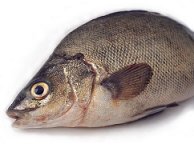
Silver perch - industry profile
 Background
Background
The silver perch (Bidyanus bidyanus) is a freshwater fish native to the Murray Darling Basin. Habitat destruction and fishing have caused natural populations to drastically decline, leading to listing the species as vulnerable.
During early 1990's, scientists at NSW Fisheries Grafton Aquaculture Centre developed techniques for the production of silver perch in ponds. Silver perch have biological characteristics suited to intensive culture including an ability to tolerate high densities, general hardiness, willingness to accept artificial feeds, non-cannibalistic nature, excellent eating qualities, and an omnivorous diet. Techniques developed by NSW Fisheries has been commercialised by industry, making silver perch the most valuable freshwater aquaculture sector in NSW.
Production Trends
Silver perch are best suited to pond culture, with current trials investigating culture in intensive recirculation systems and cage culture systems. The optimum region for production is northern NSW given the warmer water temperatures, however silver perch are grown across the state. Under optimum conditions silver perch can be grown to market size (up to 800g) within 18 months. Production has grown steadily. Research has shown silver perch can be grown at densities of 10t/ha. For the production figures see the aquaculture production reports.
The silver perch aquaculture industry is still in its infancy, with a number of issues in production still to be resolved. Significant research has been undertaken to reduce feed costs by replacing expensive fishmeal with agricultural produce eg soy, lupins etc. Work has also commenced on selective breeding of silver perch strains, and understanding health management issues during winter growing cycles.
Market/Price Trends and Opportunities
Silver perch is a new species to Australian seafood markets. To date the fish has appealed to Asian tastes, and a strong live fish trade has developed around Chinatown restaurants (live 600-800g fish for 'banquet' style cooking). However, this market is easily saturated, and growers have started developing alternative markets. Large volumes of fish are sold whole chilled, although market prices are substantially less for this product. Some growers sell fillets and value added product such as smoked fish.
Average farm gate prices for silver perch have dropped steadily in recent years, although it is expected these will stabilise over coming seasons. For the average price figures see the aquaculture production reports. Average prices on the Sydney Fish Market floor have been much lower than average farm gate prices, suggesting many growers avoid the Sydney Fish Market, instead concentrating on live or other direct markets eg restaurants, cooperatives etc. It is expected supply will continue to increase as farms intensify production. Ultimately, there are opportunities for silver perch to help replace imported white flesh fillets eg Nile perch, hoki, hake etc, provided costs of production through technology advancement and economies of scale can be reached. Some export sales have occurred with trial containers to the US and Asia, however this requires further development. The NSW Silver Perch Growers Association has appointed a consortium to undertake a market identification and development program for silver perch.
Investors or farmers can obtain marketing information from the NSW Silver Perch Growers Association, which also provides good industry networks. Reports and marketing research available include:
PSM Consulting Group P/L, 1997. Silver Perch Industry Development Plan. Report to the National Seafood Centre.
Ruello and Associates P/L, 1999. Silver Perch Market Assessment. Report to NSW Fisheries, NSW AMRAC and QDPI.
Up to date and historical auction prices (daily and monthly) from the Sydney Fish Market can be obtained from the following website: Sydney Fish Markets
Economics - Models and Information
There are tools available to assist investors examine the economic viability of silver perch, including the interactive model "Perchprofit Economic Information Package' developed by NSW DPIRD and QDPI.
The NSW Silver Perch Growers Association have also undertaken modelling for farms of a particular size (10ha-100t), and other modelling information can be found in the reports (50t, 100t farms):
University of Sydney, 2001. Investigating Emerging Industries for the Central West of NSW - Part C Finfish Aquaculture.
ABARE, (2001). Profitability of Selected Aquaculture Species . Report to the Fisheries Resources Research Fund.
ABARE, 2002. Import Competitiveness of Australian Aquaculture . Report to the Fisheries Resources Research Fund.
RIRDC, 1998. The New Rural Industries - A Handbook for Farmers and Investors.

